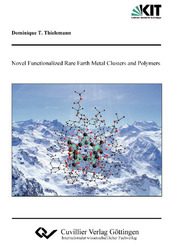| Departments | |
|---|---|
| Book Series (96) |
1378
|
| Nachhaltigkeit |
3
|
| Gesundheitswesen |
1
|
| Humanities |
2362
|
| Natural Sciences |
5406
|
| Mathematics | 229 |
| Informatics | 319 |
| Physics | 980 |
| Chemistry | 1363 |
| Geosciences | 131 |
| Human medicine | 243 |
| Stomatology | 10 |
| Veterinary medicine | 108 |
| Pharmacy | 147 |
| Biology | 835 |
| Biochemistry, molecular biology, gene technology | 121 |
| Biophysics | 25 |
| Domestic and nutritional science | 45 |
| Agricultural science | 1004 |
| Forest science | 201 |
| Horticultural science | 20 |
| Environmental research, ecology and landscape conservation | 148 |
| Engineering |
1790
|
| Common |
97
|
|
Leitlinien Unfallchirurgie
5. Auflage bestellen |
|
Advanced Search
Novel Functionalized Rare Earth Metal Clusters and Polymers (English shop)
Neuartige Funktionalisierte Seltenerdmetallcluster und Polymere
Dominique Tobias Thielemann (Author)Preview
Table of Contents, Datei (270 KB)
Extract, Datei (390 KB)
Novel functionalized rare earth metal clusters and polymers have been prepared, characterized and investigated with respect to various potential applications.
The literature known tetra- and pentanuclear rare earth metal hydroxy clusters [Ln4(?3-OH)2(Ph2acac)10] (Ln = Pr, Nd, Sm) and [Ln5(?4-OH)(?3-OH)4(Ph2acac)10] (Ln = Y, Eu) were embedded into different polymer matrices applying the miniemulsion polymerization technique to give cluster-polymer hybrid nanocompounds with narrow size distributions. The polymer matrices involved were composed of polystyrene (PS), poly(methyl methacrylate) (PMMA), poly(lauryl methacrylate) (PLMA) and poly(butyl acrylate-co-methyl methacrylate) (PBA-co-MMA). As a consequence of encapsulation, aqueous dispersions containing the hydrophobic clusters with more than 1000 mg•L-1 could be prepared. Subsequent optical investigations revealed the retention of the encapsulated clusters’ photophysical properties in aqueous dispersions. Additionally, a very efficient energy transfer from the ligand and polymeric unit to the Eu3+-ions was observed.
Envisioning a functionalization of these pure Ph2acac clusters, the pentanuclear mixed ligated rare earth metal hydroxy clusters [Ln5(?4-OH)(?3-OH)4(??AA)4(Ph2acac)6] (1-6) (Ln = Y: ??AA = D-PhGly (1), L-Pro (2), L-Val (3), L-Trp (4), Ph2Gly (5); Ln = Dy: ??AA = D-PhGly (6)) were reproducibly prepared in gram scale and the corresponding solid state structures were established via single crystal X-ray analysis. Clusters 1-6 display a square pyramidal {Ln5(?4-OH)(?3-OH)4}10+ scaffold, which is coordinatively and electronically saturated by six chelating Ph2acac ligands and four amino acid ligands acting as bridging chelates. The hydrodynamic radius rH of valine cluster 3 was determined via NMR-based PGSE diffusion experiments, revealing the retention of the cluster’s scaffold upon dissolution. Furthermore, 2D NMR experiments with 3 showed a heteronuclear cross coupling between 89Y and 1H nuclei.
Applying similar reaction conditions as for 1-6, mixed ligated pentadecanuclear clusters accommodating the bifunctionalized peptoid ligand PepCO2 of formula [Ln15(?3-OH)20(PepCO2)10(Ph2acac)10 Cl]Cl4 (Ln = Y (7), Tb (8), Dy (9)) were obtained in gram scale. ESI-MS experiments in methanol have shown that the hydroxy bridges in clusters 7-9 undergo a methanolysis. The hydrodynamic radius rH of the diamagnetic cluster 7 determined via PGSE NMR diffusion experiments agrees very well with the value deduced from the X-ray data. The 1H,89Y gHMQC spectrum of 7 has confirmed the presence of two chemically distinguishable yttrium atoms. Magnetism and susceptibility measurements of dysprosium cluster 9 have revealed a behaviour which is typical for single-molecule-magnets (SMM). Terbium cluster 8 shows emission of orange luminescence at a wavelength of 613 nm. In vitro investigations were performed by incubating HeLa tumor cells with 7-9, showing an internalization of the clusters and subsequent enrichment in either the endoplasmatic reticulum (7 and 9) or the cytosol and the nucleus (8).
Reaction of [LnCl3•(H2O)6] (Ln = Y, Nd, Dy) with ?-ketoester ethyl acetylacetate (acacOEtH) under basic conditions yielded the nonanuclear rare earth metal hydroxy clusters [Ln9(?4-O)(?4-OH)(?3-OH)8(acacOEt)16] (Ln = Y (10), Nd (11), Dy (12)).
The conversion of [NdCl3•(H2O)6] with four equivalents of Ph2acacH and KOtBu each gave a onedimensional coordination polymer of formula [K(CH2Cl2)2{Nd(Ph2acac)4]n (13), whereas analogous reactions using [PrCl3•(H2O)7] and [SmCl3•(H2O)6] afforded the literature known tetranuclear clusters [Ln4(?3-OH)2(Ph2acac)10] (Ln = Pr, Sm).
Analogous onedimensional coordination polymers [Cs{Ln(Ph2acac)4(C3H7NO)2]n (Ln = Pr (14), Nd (15), Sm (16), Dy (17)) were obtained using Cs2CO3 as base. The Ph2acac ligands of the isostructural compounds 14-17 serve to link the metal atoms by chelating and bridging in ?:?2:?2-mode. Since the ESI-MS spectra of 13-17 in DMF contain signal sets of several ionic species, complex equilibria in solution are suggested. Additionally, ultra-short-time dynamics in solution were investigated via femtosecond laser spectroscopy. The results allow an assignment of rare earth metal atom specific relaxation processes which arise from the lifetimes of their individual excited states.
| ISBN-13 (Printausgabe) | 3869556757 |
| ISBN-13 (Hard Copy) | 9783869556758 |
| ISBN-13 (eBook) | 9783736936751 |
| Final Book Format | A5 |
| Language | English |
| Page Number | 168 |
| Lamination of Cover | glossy |
| Edition | 1 Aufl. |
| Volume | 0 |
| Publication Place | Göttingen |
| Place of Dissertation | Universität Karlsruhe (KIT) |
| Publication Date | 2011-03-22 |
| General Categorization | Dissertation |
| Departments |
Chemistry
|
| Keywords | Lanthanoids,Coordination chemistry,Cluster,Polymers,Amino acids,Peptoids,Synthesis,Characterization,Luminescence,Magnetism,2D-NMR spectroscopy, In vitro applications,Electrospray ionization mass spectrometry (ESI-MS),Femtosecond laser spectroscopy |








